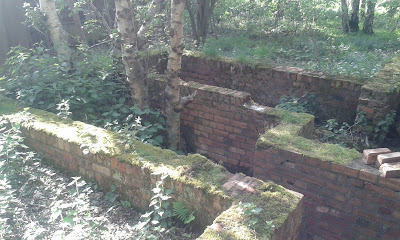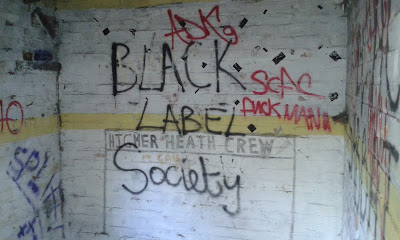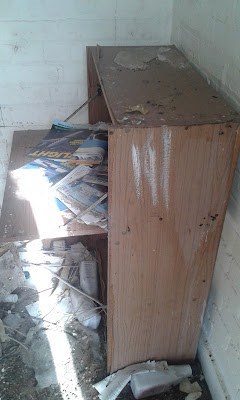The camp was apparently so large that it led to the employment of Shropshires first ever female police officers, to restrain people local to the area from wandering onto the military site.
Following World War One, Tilstock remained in the ownership of the British government until 1939, when it was turned into an internment camp for screening Polish, Austrian and German refugees, with the capacity for 2000 people. It became a Prisoner of War camp as World War Two picked up, and was closed in 1941.
It opened as an airfield in 1942, and changed its name to RAF Tilstock in 1943. It was mainly used by the RAF for the training of heavy bombers. And even after World War Two ended, RAF Tilstock remained an RAF training facility into the 1950s.
In 1964 the airfield itself fell into the use of a skydiving club and it has been used for skydiving ever since, leaving a vast plethora of ruins in the surrounding area for people to explore.
In August 2014, plans were announced to destroy them all and build houses there. But I would get there first...
The aerial shot isn't mine, but from the sky you can really get an idea for the size of the area. The majority of the old runway is now torn apart, with only a fraction remaining and a road driving right across two of the visible stripes that mark where the rest of the runway once was. How was I ever going to find anything on such a large area?
Well luckily I happened to obtain a map of the area when it was a military facility, and plan a day of not-so-aimless wandering. Of course, it wasn't complete. While areas were numbered, not all of the numerical key had avoided being cropped from the image.
But nevertheless, I headed straight for the part labeled "Battle HQ."
You might remember from my saunter around RAF Condover that these things are commonly thought to be bomb shelters and pillboxes, but they were in fact Battle HQ's constructed in the ground for the head of defence to have a secure location from which to organize the defence of the base if it came under attack. Unlike Condover, this one was a lot harder to miss, but it seemed to follow a similar layout, with the observation room at one end, hiding an exit hatch, and the main entrance at the far end. In the middle were a surprising number of rooms.
A few wasps buzzed eagerly around a crack in the wall, and I realized that the entrance was now situated on a nest of the stripy beasts. Not only that but it was flooded. I still took a quick snap of the interior, but I couldn't go in.
On the outside, the exit hatch was open. It no longer contained a ladder but the observation room was higher than the rest, so I was able to lower myself in without getting wet.
And so I did what I failed to do at RAF Condover! It's a shame it wasn't more photogenic.
The stairs were littered with phone books, of all things. But down around that corner was the flooded portion.
And as you can see there are still some wall fixtures over there. Apparently Battle HQ's will often contain a lot of untouched stuff, purely because nobody can get into them. If this is ever drained, it will be perfect to explore.
In roughly the same area I found this ruined little thing-
I probably wouldn't have thought much of it, except it had this raised slab reminiscent of the ruined little thing I found in Rednal. Can someone who knows more than me please tell me what this is?
Other than that, there wasn't an awful lot else in this particular building.
All of the more interesting ruins were a considerable distance away, and most were hidden in woodland.
There was a bomb shelter in the woods, almost identical in design to the one in Condover. This was above ground, but covered in dirt. It's interesting because most people expect bomb shelters to be below ground. But you see, most people were also born after the nuke. These facilities predate it. They just had to be resilient and hard to spot from the air.
Your typical air raid shelter was an entrance with an arched tunnel and an escape hatch. As with the battle HQ, there were no remaining ladders.
By far the saddest aspect of Tilstock was the garage. When researching the site, I found some pictures of the car still in one piece and in fairly good condition. I approached with anticipation.
But sadly, the car has now been torn apart for scrap. It's a tremendous shame.
Beyond that, more ruins waited for me...
Here's an old picture frame, no longer framing anything.
Well, you can see that there used to be some signs on the walls there by the door. Nearby a sign did remain, but the misspelling makes me question its authenticity. It still looks cool though.
I kept seeing "Martin Wardle" scratched into walls.
Here we have a larger version of that thing I was pondering at Rednal. It has low walls, but no roof. I have no idea what sort of purpose this collection of walls would serve.
Nearby was what was unmistakably a toilet block.
I couldn't help but smile at the sight of a stolen road sign mounted on the wall.
There was a large building with no windows. It was composed of three spaceous rooms, and was full of rubbish. Its interior was primarily yellow.
A bricked up doorway, presumably another exit.
And a little further away, there was a second air raid shelter identical in layout to the previous one, albeit slightly more vandalized.
This one seemed a lot more creepier and atmospherically unwelcoming. Of course, that might be because of those suspicious motionless human shapes wrapped in sleeping bags there.
RAF Tilstock is rumoured to be haunted though, especially in one particular building. And I can really see why. It's a huge single storey labyrinthian complex that has no windows, and as such is pitch black and has the unpleasant sensation, at least for me, that one is being followed and watched. But as creepy as it was, I really hated the thought of leaving! Worse still, my phone is rubbish at taking photos in the dark!!! When I save for an amazing DSLR, I'll be returning to Tilstock definitely.
It looks much less ominous from the outside. Lets slip inside...
As I made my way around, I was careful to check every room, mostly for drug addicts, homeless people, and anyone else who might be lurking. As I said, there was an eerie feeling of being followed, and no matter how often I checked every nook and cranny, this feeling was unshakable. Of course, it's hard not to feel nervous in a pitch black labyrinth. It's not the sort of place anyone wants to be snuck up on, so make of these spooky vibes what you will, ghost enthusiasts.
An old air vent over a toilet cubicle.
This particular portion of the building had about an inch of flooding. The atmosphere was also at its most hostile here.
Very few of the ventilation systems were still bound to the ceiling.
In one room were a series of horizontal floor slabs. I have no idea what these were for. Maybe a hospital area or a morque.
"Ozzy" is written on the wall there. It's funny though, because that is the only graffiti in the supposedly haunted labyrinth, and a lot of the other surrounding buildings had plenty of it. I guess even the neighbourhood kids, and the likes of Martin Wardle, don't come down these parts.
It's debatable if that makes them more sensible than me or not.
I did find this wonderful gem- the original telephone exchange!
Further away I found a building with a curtain of ivy falling down over the doorway, like some hippie door beads made out of nature. The building was a really peaceful shade of blue on the inside, and one could see where things used to hang on the walls.
Further away was this long building that was somehow even more eerie in its own peculiar way.
All the doors were numbered. It reminded me of the prison camp in V for Vendetta, not that I'm confirming it was a prison camp or anything. I'm referring to the book, of course. I haven't actually seen the movie, because Alan Moores work typically doesn't get translated to the screen very well. I mean Watchmen was an impressive effort, and even had a superior ending, but the book had so much read-between-the-lines backstory one can't get from a movie. But I digress, magnificently.
This building is a long coridor lined with numbered doors, and I have no idea whether the numbering is an original feature or something added later.
Shortly after checking these places out, I took a look at the runway.
Much of the runway was now used for skydiving. The parts that were no longer paved over were distinguishable only by the differences in the colour of the grass around it.
On this area I did find an unusual tiny derelict building.
Inside we have a blackboard with very faint writing, old clip boards and old maps. I have no idea how recently any of this stuff was discarded, although I doubt it dates back to the 1940s.
But lastly, what of the allegedly derelict RAF control tower?
Well to be honest, I have no idea what they're doing to it.
There's no way in, but you can still see that there used to be stairs from the balcony to the roof, much like the one at Condover. But it's gone. The entire building is painted in this ghastly mock army colouration, and the only clue that whoever did it cares even remotely about the history of the thing they've defaced is the presence of noticeboards telling the history of Tilstock.
It's like they tried to turn RAF Tilstock into a tourist attraction and then gave up.
Imagine that pitch to the tourists.
"Hi guys, come to RAF Tilstock. Learn about the history of the place by reading off the exterior of our main attraction that you can't actually go inside. Don't go near the ruins in the woods though, they're not safe. Wait, I said don't go there! Come back! Ah, fuck it. I should've been a dentist..."
Anyway, thanks for checking out RAF Tilstock. Tilstock was the fourth and final of the allegedly derelict RAF control towers still standing in Shropshire, although by far not the last abandoned military facility. Shropshire had hundreds back in the day. It was probably a strategic advantage since the Germans were so busy bombing London and other major cities, of which Shropshire has none.
I can't wait to return to Tilstock someday. If anyone has any additional information about RAF Tilstock, or any of the places featured on this blog, or even if you just want to chat, get in touch. Find me online and we'll be buddies.
twitter- Urbexshropshire
Instagram- shrewsburyfromwhereyouarenot
www.facebook.com/shrewsburyfromwhereyouarenot
The best is yet to be. Stay awesome, all of you.


























































































































































































































I know these buildings, I used to roller skate down the toilet block. About 1959 my family holidayed there at my Aunty Dorothy's house on the old Airfield, happy memories, not spooky at all, I loved exploring those old buildings, been looking for a while for photos of it so thanks. Maureen Reid.
ReplyDelete".... a larger version of that thing I was pondering at Rednal. It has low walls, but no roof."
ReplyDeleteBlast shelter.